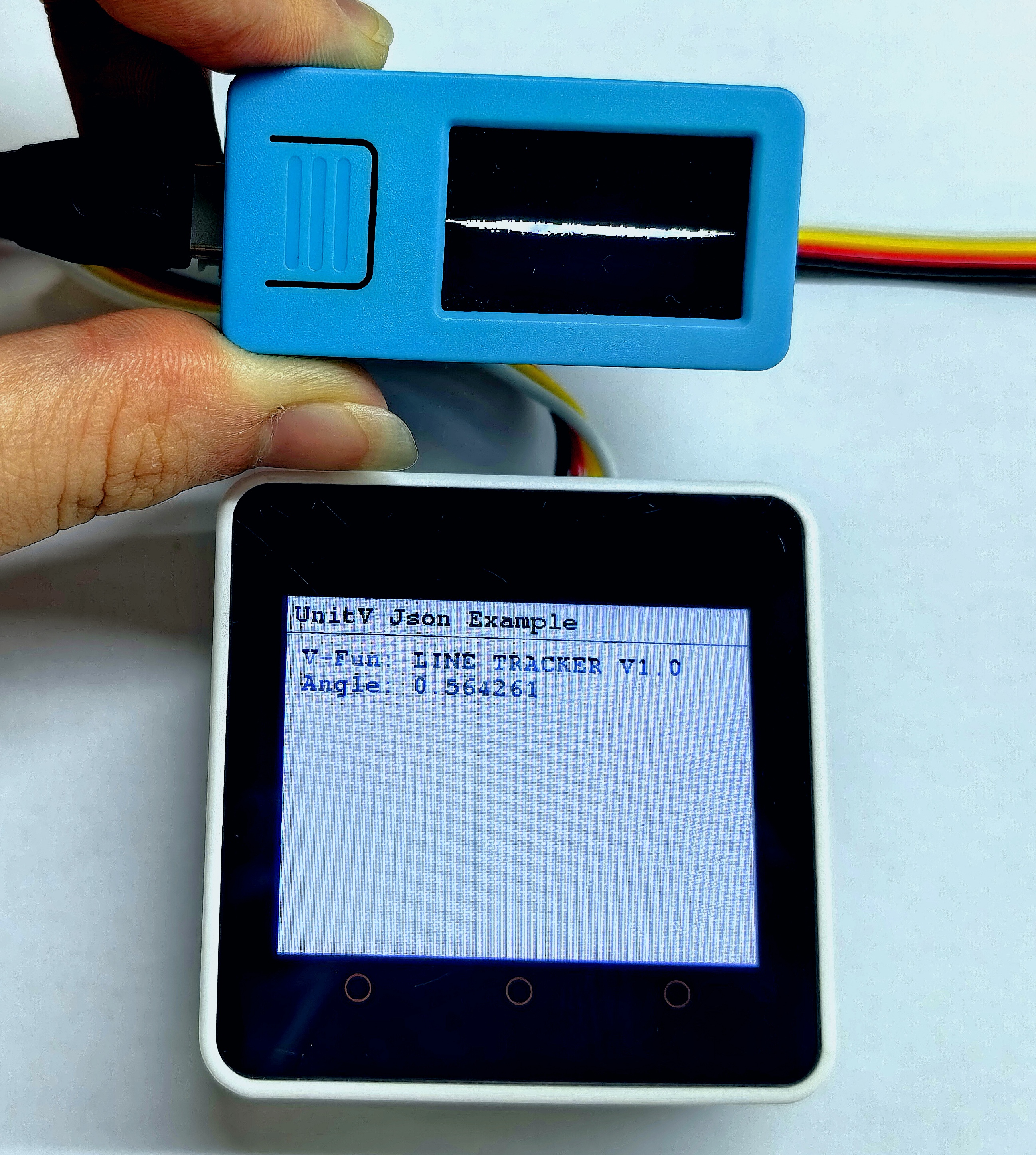UnitV/StickV Arduino 使用教程
1. 准备工作
环境配置: 参考 Arduino IDE 上手教程完成 IDE 安装,并根据实际使用的开发板安装对应的板管理,与需要的驱动库。
使用到的驱动库:
使用到的硬件产品:




2. 注意事项
3. 编译上传
- 请根据需要复制粘贴下方例程代码到项目代码区,然后选中设备端口(详情请参考 程序编译与烧录),点击 Arduino IDE 左上角编译上传按钮,等待程序完成编译并上传至设备。
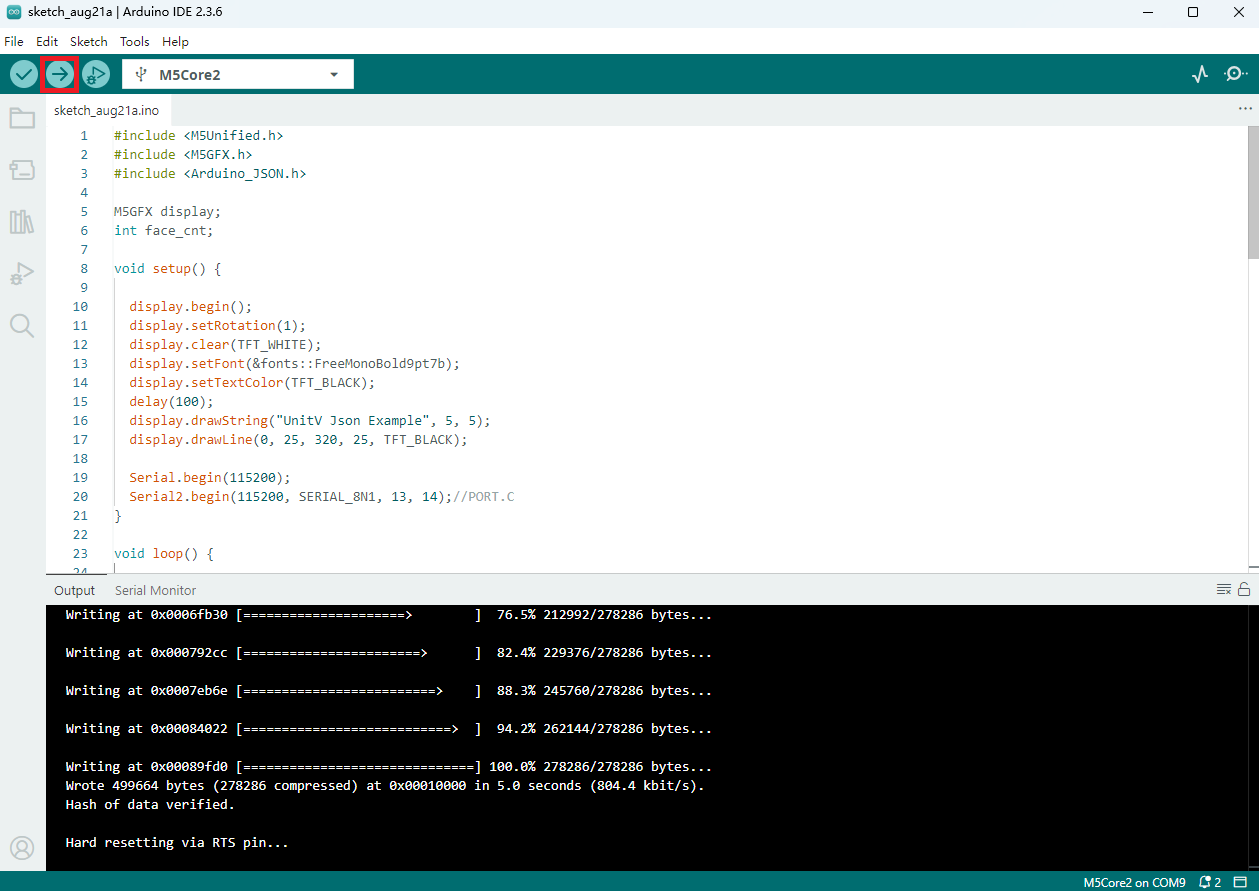
4. 案例程序
2.UnitV/StickV 需要通过 USB Type-C 接口供电才能工作,USB Type-C 接口拔插后本单元会重启。
3.M5Burner 中的固件并非所有功能下都有默认参数设置,且本单元设置的参数掉电会丢失,故本单元断电重启后需要再配置一次设置参数。
下方所有例程功能为主机配置和解析 UnitV/StickV 的 JSON 数据,不能达到切换 UnitV/StickV 的功能,切换功能请在 M5Burner 中 STICKV & UNITV 界面中选择烧录对应功能固件到 UnitV/StickV。
4.1 运动目标检测
该功能固件如下:
运动目标检测功能可配置两种检测模式:静态检测模式(COMPUTE_MODE_STATIC)和动态检测模式(COMPUTE_MODE_DYNAMIC),M5Burner 中的固件默认为动态检测模式。
运动目标检测功能 JSON 数据格式详见此处。
#include <M5Unified.h>
#include <M5GFX.h>
#include <Arduino_JSON.h>
M5GFX display;
int motion_cnt = 0;
void setup() {
display.begin();
display.setRotation(1);
display.clear(TFT_WHITE);
display.setFont(&fonts::FreeMonoBold9pt7b);
display.setTextColor(TFT_BLACK);
delay(100);
display.drawString("UnitV Json Example", 5, 5);
display.drawLine(0, 25, 320, 25, TFT_BLACK);
Serial.begin(115200);
Serial2.begin(115200, SERIAL_8N1, 13, 14);//PORT.C
//Setting JSON
JSONVar obj;
obj["MOTION DETECT"] = 1.0; // Not optional
obj["mode"] = "COMPUTE_MODE_DYNAMIC"; // "COMPUTE_MODE_STATIC" or "COMPUTE_MODE_DYNAMIC"
obj["thr_w"] = 20; // optional
obj["thr_h"] = 20; // optional
obj["stepx"] = 1; // optional
obj["stepy"] = 2; // optional
obj["delta"] = 20; // optional
obj["merge"] = 10; // optional
String jsonString = JSON.stringify(obj);
Serial2.println(jsonString);
Serial2.flush();
}
void loop() {
if (Serial2.available() > 0) {
String line = Serial2.readStringUntil('\r');
while (line.length() && line[0] != '{') {// clear '\0'
line.remove(0, 1);
}
Serial2.flush();
JSONVar motion_detect_obj = JSON.parse(line);
// JSON.typeof(jsonVar) can be used to get the type of the var
if (!(JSON.typeof(motion_detect_obj) == "undefined")){
display.fillRect(0, 35, 320, 205, TFT_WHITE);
Serial.println(">>>>>>>>>>>>>>>>>>>>>>>>>>>>>>>>>>");
Serial.println("M5Stack Motion Detect V-Func example");
if (motion_detect_obj.hasOwnProperty("FUNC")) {
Serial.print("V-Function = ");
Serial.println((const char*) motion_detect_obj["FUNC"]);
display.setCursor(0, 35);
display.printf(" V-Fun: %s\n", (const char*) motion_detect_obj["FUNC"]);
}
if (motion_detect_obj.hasOwnProperty("DIFF TOTAL")) {
Serial.print("Diff TOTAL = ");
Serial.println((int)motion_detect_obj["DIFF TOTAL"]);
display.printf(" Diff TOTAL: %d\n", (int)motion_detect_obj["DIFF TOTAL"]);
}
if (motion_detect_obj.hasOwnProperty("DIFF MAX")) {
Serial.print("Diff MAX = ");
Serial.println((int)motion_detect_obj["DIFF MAX"]);
display.printf(" Diff MAX: %d\n", (int)motion_detect_obj["DIFF MAX"]);
}
if (motion_detect_obj.hasOwnProperty("TOTAL")) {
motion_cnt = (int)motion_detect_obj["TOTAL"];
Serial.printf("Motion number = %d\n", motion_cnt);
display.printf(" Motion number: %d\n", motion_cnt);
}
for (int i = 0; i < motion_cnt; i++) {
display.setCursor(0, 120);
display.fillRect(0, 120, 320, 130, TFT_WHITE);
Serial.print("Motion ");
Serial.print(i);
display.printf("Motion %d:", i);
Serial.print(":\r\n\tX:");
Serial.println((int) motion_detect_obj[String(i)]["x"]);
display.printf("\r\n\t X: %d", (int) motion_detect_obj[String(i)]["x"]);
Serial.print("\tY:");
Serial.println((int) motion_detect_obj[String(i)]["y"]);
display.printf("\r\n\t Y: %d", (int) motion_detect_obj[String(i)]["y"]);
Serial.print("\tWidth:");
Serial.println((int) motion_detect_obj[String(i)]["w"]);
display.printf("\r\n\t Width: %d", (int) motion_detect_obj[String(i)]["w"]);
Serial.print("\tHeight:");
Serial.println((int) motion_detect_obj[String(i)]["h"]);
display.printf("\r\n\t Height: %d", (int) motion_detect_obj[String(i)]["h"]);
Serial.print("\tArea:");
Serial.println((int) motion_detect_obj[String(i)]["area"]);
display.printf("\r\n\t Area: %d", (int) motion_detect_obj[String(i)]["area"]);
delay(500);
}
Serial.println("<<<<<<<<<<<<<<<<<<<<<<<<<<<<<<<<<<");
} else {
return;
}
}
}上方例程使用动态检测模式,当 StickV/UnitV 检测到物体运动时,会实时反馈物体所处位置等数据,检测结果如下图所示。
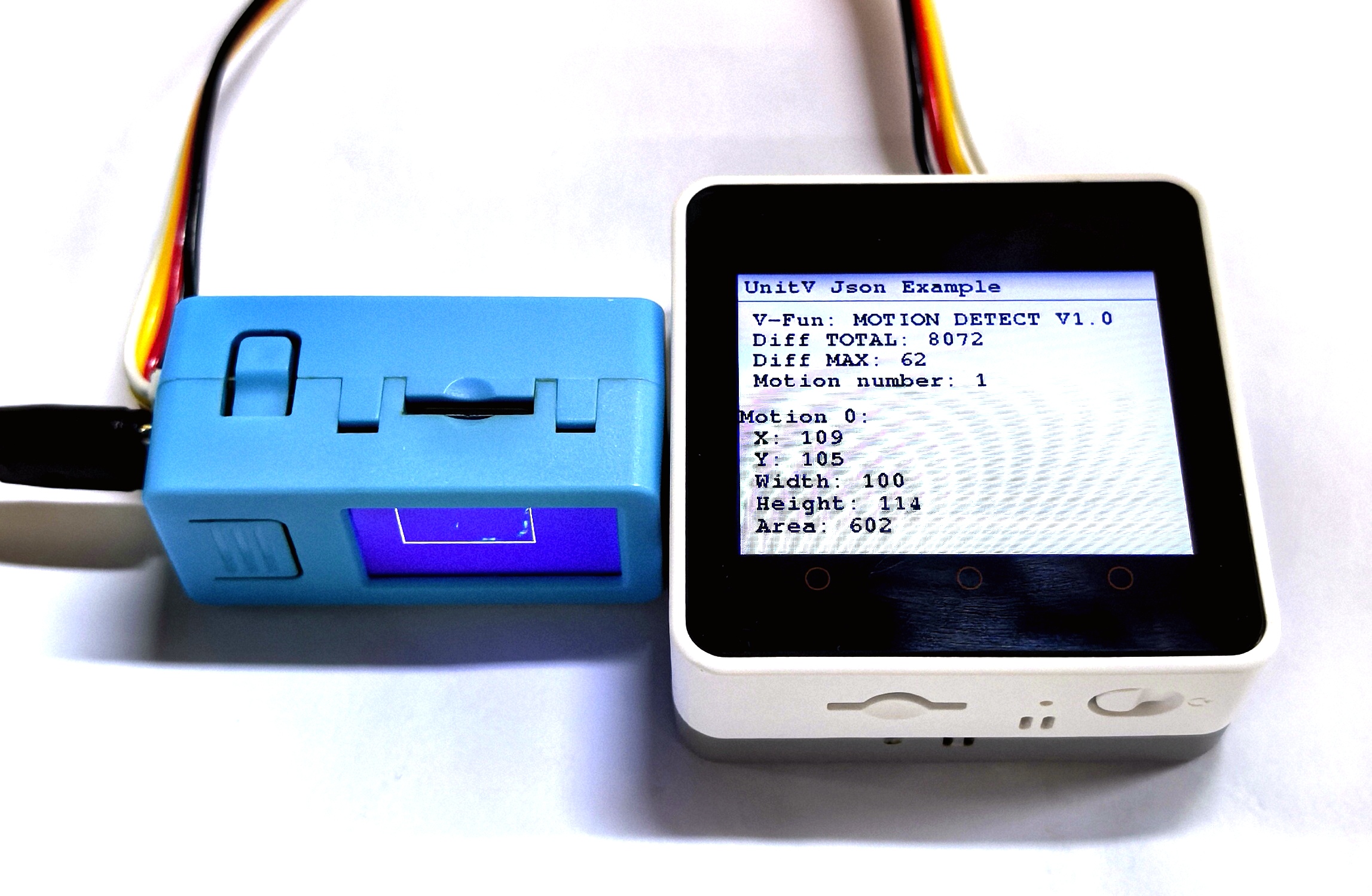
4.2 目标追踪
该功能固件如下:
目标追踪功能需要在 UnitV/StickV 上电后抓取目前摄像头画面中目标物体的信息后才能正常使用,抓取起点及长宽参数设置代码如下所示,想要自定义抓取位置请修改此处。
obj["x"] = 80; //start point x-coordinate
obj["y"] = 0; //start point y-coordinate
obj["w"] = 100; //width
obj["h"] = 100; //heigth目标追踪功能 JSON 数据格式详见此处。
下方例程会在主机上电后发送一次参数设置数据,此时 StickV 页面如下图所示,请确保追踪目标位于黄色抓取框中。
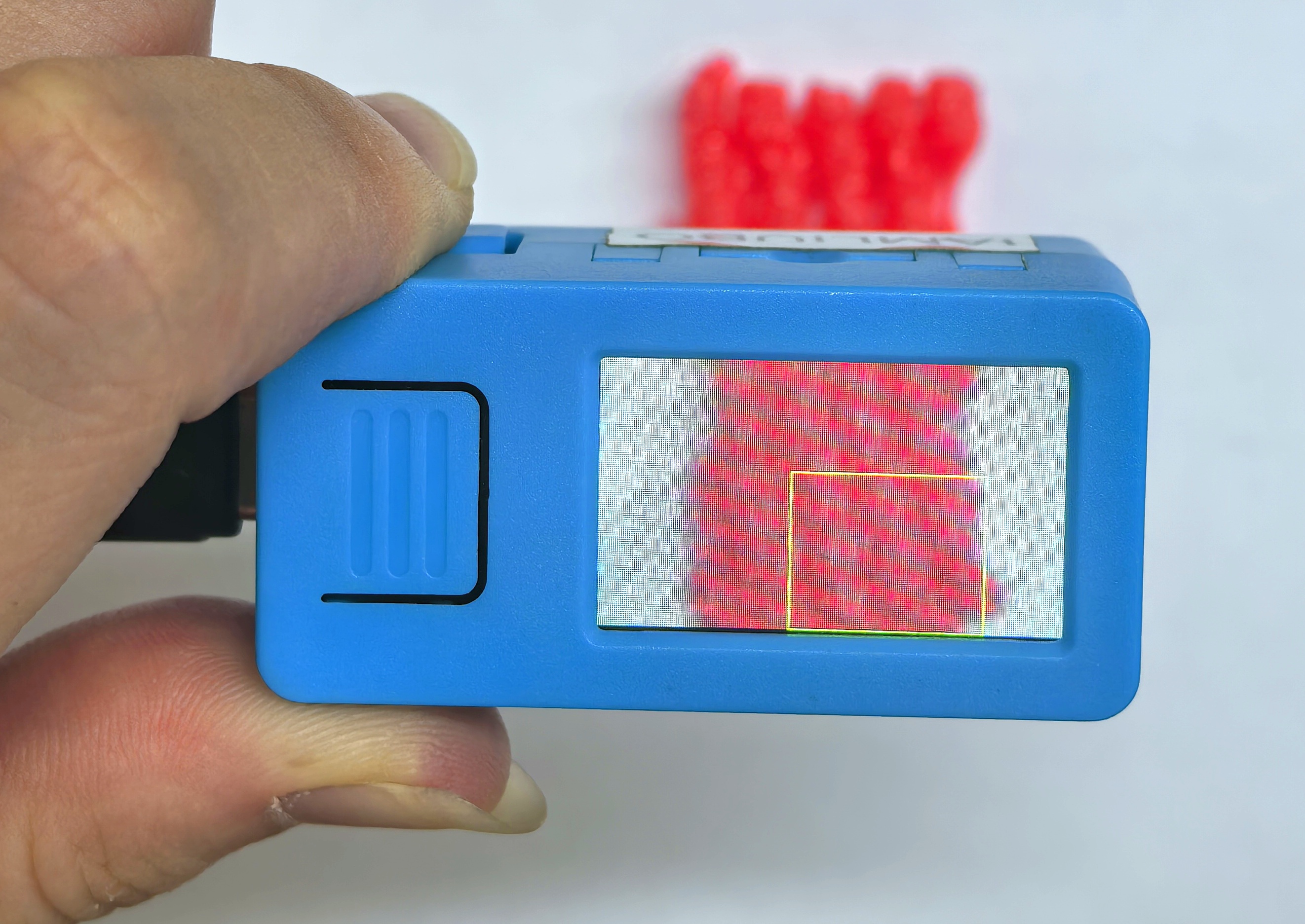
#include <M5Unified.h>
#include <M5GFX.h>
#include <Arduino_JSON.h>
M5GFX display;
void setup() {
display.begin();
display.setRotation(1);
display.clear(TFT_WHITE);
display.setFont(&fonts::FreeMonoBold9pt7b);
display.setTextColor(TFT_BLACK);
delay(100);
display.drawString("UnitV Json Example", 5, 5);
display.drawLine(0, 25, 320, 25, TFT_BLACK);
Serial.begin(115200);
Serial2.begin(115200, SERIAL_8N1, 13, 14);//PORT.C
//Setting JSON
JSONVar obj;
obj["TARGET TRACKER"] = " V1.0";
obj["x"] = 80;
obj["y"] = 0;
obj["w"] = 100;
obj["h"] = 100;
String jsonString = JSON.stringify(obj);
Serial2.println(jsonString);
Serial2.flush();
}
void loop() {
if (Serial2.available() > 0) {
String line = Serial2.readStringUntil('\r');
while (line.length() && line[0] != '{') { // clear '\0'
line.remove(0, 1);
}
Serial2.flush();
JSONVar object = JSON.parse(line);
// JSON.typeof(jsonVar) can be used to get the type of the var
if (!(JSON.typeof(object) == "undefined")){
display.fillRect(0, 35, 320, 205, TFT_WHITE);
Serial.println(">>>>>>>>>>>>>>>>>>>>>>>>>>>>>>>>>>");
Serial.println("M5Stack Target Tracker V-Func example");
if (object.hasOwnProperty("FUNC")) {
Serial.print("V-Function = ");
Serial.println((const char*) object["FUNC"]);
display.setCursor(0, 35);
display.printf(" V-Fun: %s\n", (const char*) object["FUNC"]);
}
if (object.hasOwnProperty("x")) {
Serial.print("X: ");
Serial.println((int) object["x"]);
display.printf(" X: %d\n", (int) object["x"]);
}
if (object.hasOwnProperty("y")) {
Serial.print("Y: ");
Serial.println((int) object["y"]);
display.printf(" Y: %d\n", (int) object["y"]);
}
if (object.hasOwnProperty("w")) {
Serial.print("Width: ");
Serial.println((int) object["w"]);
display.printf(" Width: %d\n", (int) object["w"]);
}
if (object.hasOwnProperty("h")) {
Serial.print("Height: ");
Serial.println((int) object["h"]);
display.printf(" Height: %d\n", (int) object["h"]);
}
display.waitDisplay();
Serial.println("<<<<<<<<<<<<<<<<<<<<<<<<<<<<<<<<<<");
} else {
return;
}
}
}成功抓取目标物体数据后,主机会实时显示打印目标物体所处位置等数据,检测结果如下图所示。
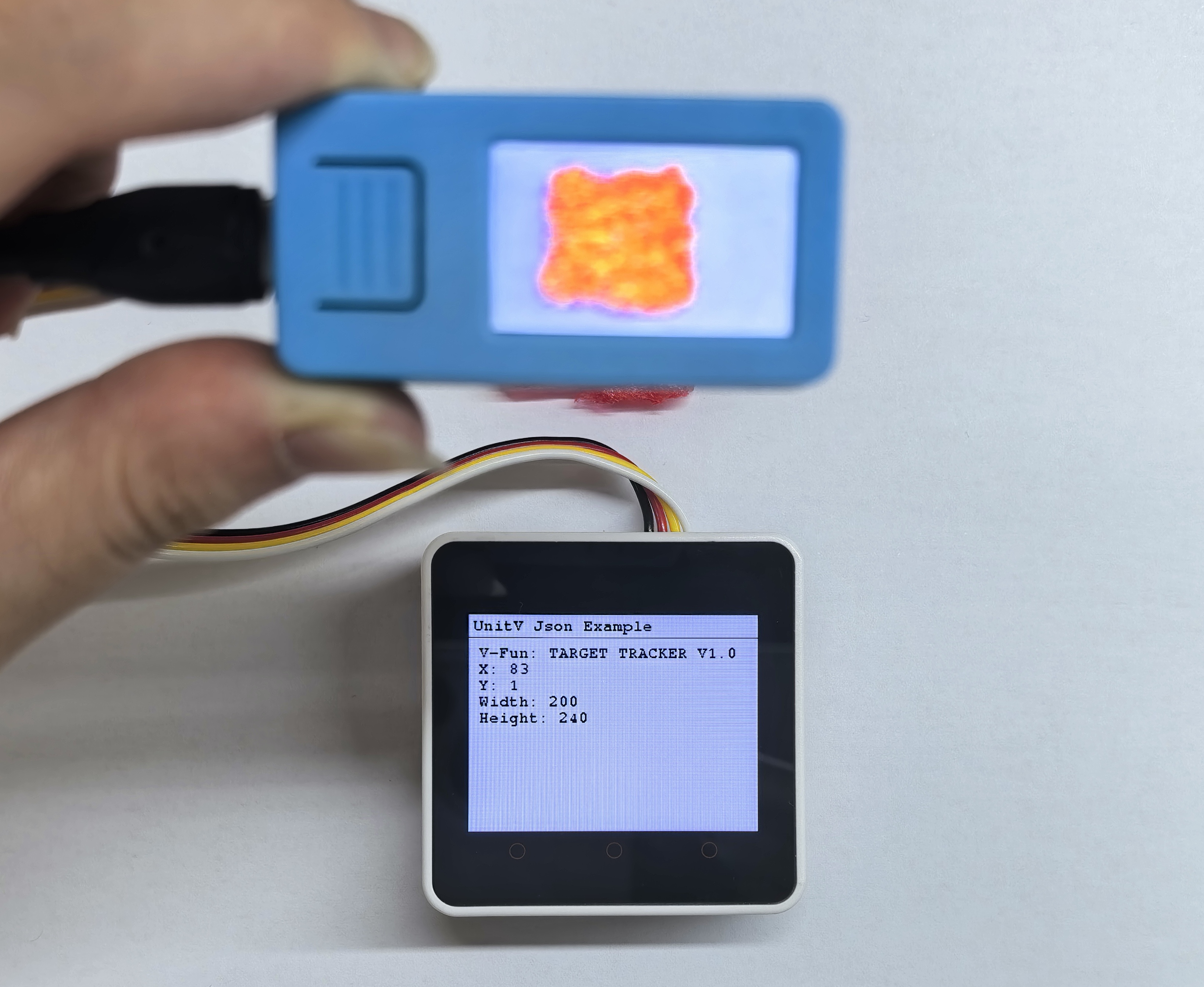
4.3 颜色追踪
该功能固件如下:
颜色追踪功能需要在 UnitV/StickV 上电后设置所追踪颜色参数才能正常使用,颜色参数获取需要使用LAB 取色工具。
获取颜色参数获取及配置步骤如下:
- 打开工具后点击下方所示工具页面的
open处打开采样图片(本例程示例图片),然后点击图片中需要采样的具体位置,根据下方白色区域(即采样具体位置)确定最终的颜色参数。

- 将上图中的
LAB color按照从左到右的顺序填入下方代码处(从上到下)即可。
obj["Lmin"] = 0;
obj["Lmax"] = 100;
obj["Amin"] = 51;
obj["Amax"] = 61;
obj["Bmin"] = 34;
obj["Bmax"] = 44;颜色追踪功能 JSON 数据格式详见此处。
#include <M5Unified.h>
#include <M5GFX.h>
#include <Arduino_JSON.h>
M5GFX display;
void setup() {
display.begin();
display.setRotation(1);
display.clear(TFT_WHITE);
display.setFont(&fonts::FreeMonoBold9pt7b);
display.setTextColor(TFT_BLACK);
delay(100);
display.drawString("UnitV Json Example", 2, 2);
display.drawLine(0, 20, 320, 20, TFT_BLACK);
Serial.begin(115200);
Serial2.begin(115200, SERIAL_8N1, 13, 14);//PORT.C
//Setting JSON
JSONVar obj;
obj["COLOR TRACKER"] = 1.0;
obj["thr_w"] = 20;
obj["thr_h"] = 20;
obj["stepx"] = 2;
obj["stepy"] = 2;
obj["merge"] = 10;
//Please fill in the below six parameters with the values extracted from the LAB color selection tool.
obj["Lmin"] = 0;
obj["Lmax"] = 100;
obj["Amin"] = 51;
obj["Amax"] = 61;
obj["Bmin"] = 34;
obj["Bmax"] = 44;
String jsonString = JSON.stringify(obj);
Serial2.println(jsonString);
Serial2.flush();
}
void loop() {
if (Serial2.available() > 0) {
String line = Serial2.readStringUntil('\r');
while (line.length() && line[0] != '{') { // clear '\0'
line.remove(0, 1);
}
Serial2.flush();
JSONVar color_obj = JSON.parse(line);
// JSON.typeof(jsonVar) can be used to get the type of the var
if (!(JSON.typeof(color_obj) == "undefined")) {
display.fillRect(0, 35, 320, 205, TFT_WHITE);
Serial.println(">>>>>>>>>>>>>>>>>>>>>>>>>>>>>>>>>>");
Serial.println("M5Stack Color Tracker V-Func example");
if (color_obj.hasOwnProperty("FUNC")) {
Serial.print("V-Function = ");
Serial.println((const char*) color_obj["FUNC"]);
display.setCursor(0, 35);
display.printf(" V-Fun: %s\n", (const char*) color_obj["FUNC"]);
}
int box_cnt = 0;
if (color_obj.hasOwnProperty("TOTAL")) {
box_cnt = (int)color_obj["TOTAL"];
Serial.printf("Box number = %d\n", box_cnt);
display.printf(" Box number: %d\n", box_cnt);
}
for (int i = 0; i < box_cnt; i++) {
Serial.print("Box ");
Serial.print(i);
display.printf("Box %d:", i);
Serial.print(":\r\n\tX:");
Serial.println((int) color_obj[String(i)]["x"]);
display.printf("\r\n\t X: %d", (int) color_obj[String(i)]["x"]);
Serial.print("\tY:");
Serial.println((int) color_obj[String(i)]["y"]);
display.printf("\r\n\t Y: %d", (int) color_obj[String(i)]["y"]);
Serial.print("\tWidth:");
Serial.println((int) color_obj[String(i)]["w"]);
display.printf("\r\n\t Width: %d", (int) color_obj[String(i)]["w"]);
Serial.print("\tHeight:");
Serial.println((int) color_obj[String(i)]["h"]);
display.printf("\r\n\t Height: %d", (int) color_obj[String(i)]["h"]);
Serial.print("\tArea:");
Serial.println((int) color_obj[String(i)]["area"]);
display.printf("\r\n\t Area: %d\r\n\t", (int) color_obj[String(i)]["area"]);
}
Serial.println("<<<<<<<<<<<<<<<<<<<<<<<<<<<<<<<<<<");
}
delay(50);
}
} 例程成功运行时,主机会实时显示打印追踪颜色块所处位置、大小、数量等数据,检测结果如下图所示。(多个追踪颜色块情况下建议使用串口查看反馈数据)
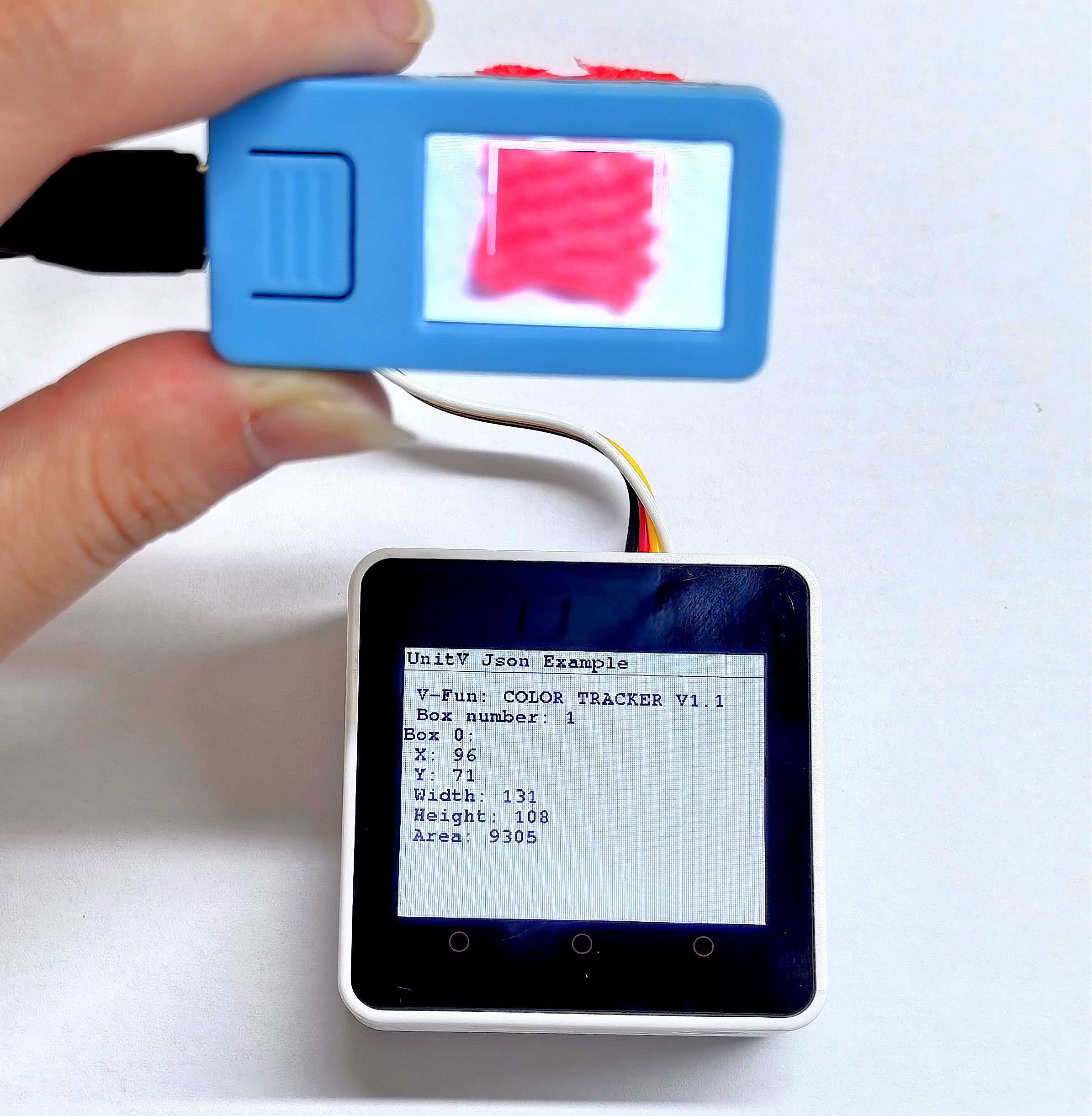
4.4 人脸检测
该功能固件如下:

人脸检测功能 JSON 数据格式详见此处。
#include <M5Unified.h>
#include <M5GFX.h>
#include <Arduino_JSON.h>
M5GFX display;
int face_cnt;
void setup() {
display.begin();
display.setRotation(1);
display.clear(TFT_WHITE);
display.setFont(&fonts::FreeMonoBold9pt7b);
display.setTextColor(TFT_BLACK);
delay(100);
display.drawString("UnitV Json Example", 5, 5);
display.drawLine(0, 25, 320, 25, TFT_BLACK);
Serial.begin(115200);
Serial2.begin(115200, SERIAL_8N1, 13, 14);//PORT.C
}
void loop() {
if (Serial2.available() > 0) {
String line = Serial2.readStringUntil('\r');
while (line.length() && line[0] != '{') { // clear '\0'
line.remove(0, 1);
}
Serial2.flush();
JSONVar face_detect_obj = JSON.parse(line);
// JSON.typeof(jsonVar) can be used to get the type of the var
if (!(JSON.typeof(face_detect_obj) == "undefined")) {
display.fillRect(0, 35, 320, 205, TFT_WHITE);
// display.drawString("Parsing Json succeed!", 5, 30);
Serial.println(">>>>>>>>>>>>>>>>>>>>>>>>>>>>>>>>>>");
Serial.println("M5Stack Face Detect V-Func example");
if (face_detect_obj.hasOwnProperty("FUNC")) {
Serial.print("V-Function = ");
Serial.println((const char*)face_detect_obj["FUNC"]);
display.setCursor(0, 35);
display.printf(" V-Fun: %s\n", (const char*)face_detect_obj["FUNC"]);
}
if (face_detect_obj.hasOwnProperty("count")) {
face_cnt = (int)face_detect_obj["count"];
Serial.printf("Face number = %d\n", face_cnt);
display.printf(" Face number: %d\n", face_cnt);
}
for (int i = 0; i < face_cnt; i++) {
Serial.print("Face ");
Serial.print(i + 1);
display.printf("Face %d:", i);
Serial.print(":\r\n\tX:");
Serial.println((int)face_detect_obj[String(i)]["x"]);
display.printf("\r\n\t X: %d", (int)face_detect_obj[String(i)]["x"]);
Serial.print("\tY:");
Serial.println((int)face_detect_obj[String(i)]["y"]);
display.printf("\r\n\t Y: %d", (int)face_detect_obj[String(i)]["y"]);
Serial.print("\tWidth:");
Serial.println((int)face_detect_obj[String(i)]["w"]);
display.printf("\r\n\t Width: %d", (int)face_detect_obj[String(i)]["w"]);
Serial.print("\tHeight:");
Serial.println((int)face_detect_obj[String(i)]["h"]);
display.printf("\r\n\t Height: %d", (int)face_detect_obj[String(i)]["h"]);
Serial.print("\tConfidence:");
Serial.println(face_detect_obj[String(i)]["value"]);
display.printf("\r\n\t Confidence:");
display.println(face_detect_obj[String(i)]["value"]);
}
Serial.println("<<<<<<<<<<<<<<<<<<<<<<<<<<<<<<<<<<");
} else {
return;
}
}
} 扫描下方左边人脸,检测结果如下方右图所示。

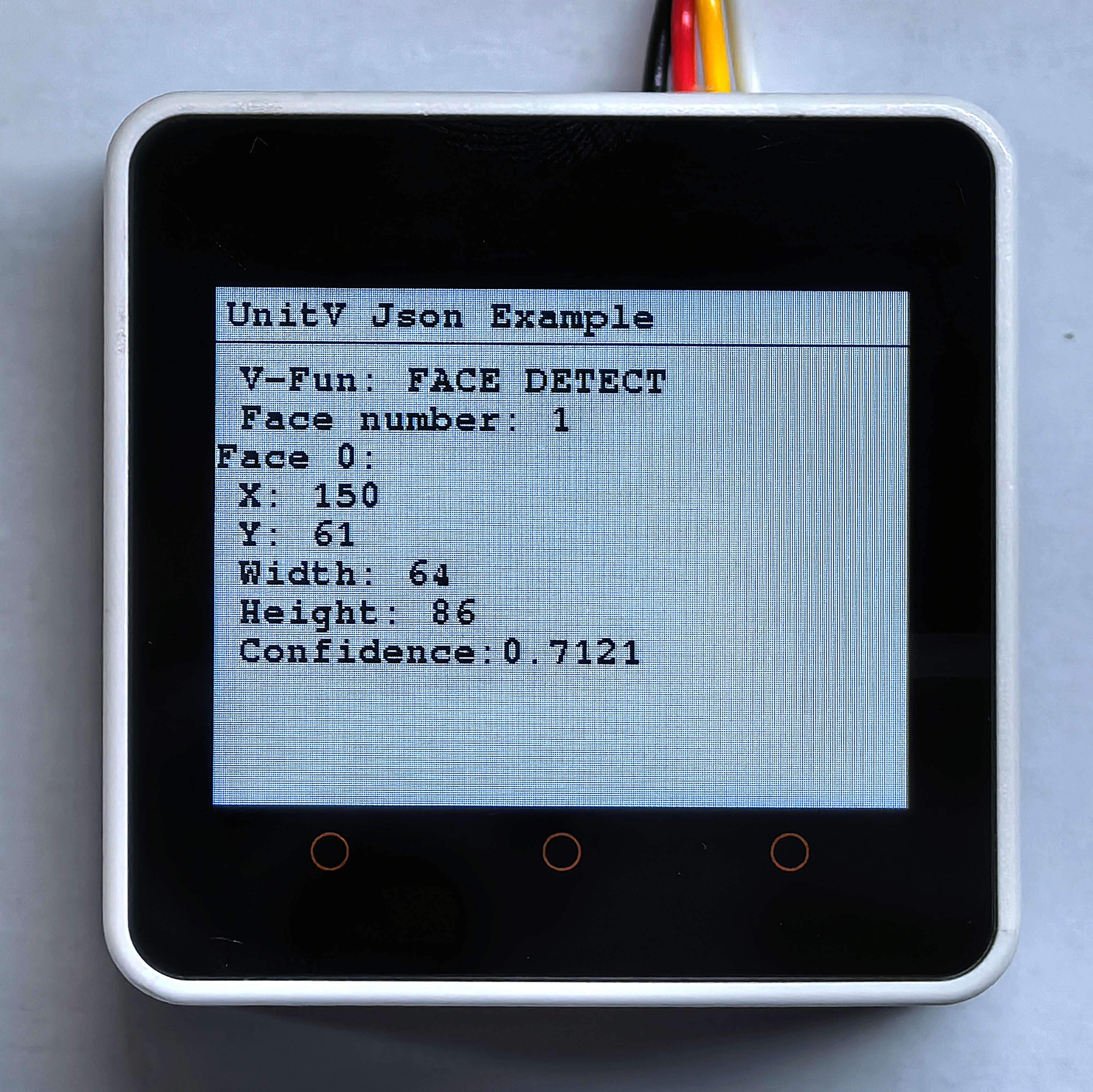
4.5 二维码识别
扫码功能固件如下:

二维码识别功能 JSON 数据格式详见此处。
#include <M5Unified.h>
#include <M5GFX.h>
#include <Arduino_JSON.h>
M5GFX display;
void setup() {
display.begin();
display.setRotation(1);
display.clear(TFT_WHITE);
display.setFont(&fonts::FreeMonoBold9pt7b);
display.setTextColor(TFT_BLACK);
delay(100);
display.drawString("UnitV Json Example", 5, 5);
display.drawLine(0, 25, 320, 25, TFT_BLACK);
Serial.begin(115200);
Serial2.begin(115200, SERIAL_8N1, 13, 14);//PORT.C
//Setting JSON
JSONVar obj;
obj["FIND CODE"] = 1.0;
obj["mode"] = "QRCODE"; // Recognition mode, optional: QRCODE, APRILTAG, DATAMATRIX, BARCODE
String jsonString = JSON.stringify(obj);
Serial2.println(jsonString);
Serial2.flush();
}
void loop() {
if (Serial2.available() > 0) {
String line = Serial2.readStringUntil('\r');
while (line.length() && line[0] != '{') { // clear '\0'
line.remove(0, 1);
}
Serial2.flush();
JSONVar code_obj = JSON.parse(line);
// JSON.typeof(jsonVar) can be used to get the type of the var
if (!(JSON.typeof(code_obj) == "undefined")){
display.fillRect(0, 35, 320, 205, TFT_WHITE);
Serial.println(">>>>>>>>>>>>>>>>>>>>>>>>>>>>>>>>>>");
Serial.println("M5Stack QRCode Detect V-Func example");
if (code_obj.hasOwnProperty("FUNC")) {
Serial.print("V-Function = ");
Serial.println((const char*) code_obj["FUNC"]);
display.setCursor(0, 35);
display.printf(" V-Fun: %s\n", (const char*) code_obj["FUNC"]);
}
int qrcode_cnt = 0;
if (code_obj.hasOwnProperty("count")) {
qrcode_cnt = (int)code_obj["count"];
Serial.printf("QR Code number = %d\n", qrcode_cnt);
display.printf(" QR Code number: %d\n", qrcode_cnt);
}
for (int i = 0; i < qrcode_cnt; i++) {
Serial.print("QRCode ");
Serial.print(i);
display.printf("QRCode %d:", i);
Serial.print(":\r\n\tX:");
Serial.println((int) code_obj[String(i)]["x"]);
display.printf("\r\n\t X: %d", (int) code_obj[String(i)]["x"]);
Serial.print("\tY:");
Serial.println((int) code_obj[String(i)]["y"]);
display.printf(" Y: %d", (int) code_obj[String(i)]["y"]);
Serial.print("\tWidth:");
Serial.println((int) code_obj[String(i)]["w"]);
display.printf("\r\n\t Width: %d", (int) code_obj[String(i)]["w"]);
Serial.print("\tHeight:");
Serial.println((int) code_obj[String(i)]["h"]);
display.printf(" Height: %d", (int) code_obj[String(i)]["h"]);
Serial.print("\tPayload:");
Serial.println((const char*) code_obj[String(i)]["payload"]);
display.printf("\r\n\t Payload: %s", (const char*) code_obj[String(i)]["payload"]);
Serial.print("\tVersion:");
Serial.println((int) code_obj[String(i)]["version"]);
display.printf("\r\n\t Version: %d", (int) code_obj[String(i)]["version"]);
Serial.print("\tECC Level:");
Serial.println((int) code_obj[String(i)]["ecc_level"]);
display.printf("\r\n\t ECC Level: %d", (int) code_obj[String(i)]["ecc_level"]);
Serial.print("\tMask:");
Serial.println((int) code_obj[String(i)]["mask"]);
display.printf("\r\n\t Mask: %d", (int) code_obj[String(i)]["mask"]);
Serial.print("\tData Type:");
Serial.println((int) code_obj[String(i)]["data_type"]);
display.printf("\r\n\t Data Type: %d", (int) code_obj[String(i)]["data_type"]);
Serial.print("\tECI:");
Serial.println((int) code_obj[String(i)]["eci"]);
display.printf("\r\n\t ECI: %d", (int) code_obj[String(i)]["eci"]);
}
Serial.println("<<<<<<<<<<<<<<<<<<<<<<<<<<<<<<<<<<");
}
delay(50);
}
}扫描下方左边二维码,检测结果如下方右图所示。

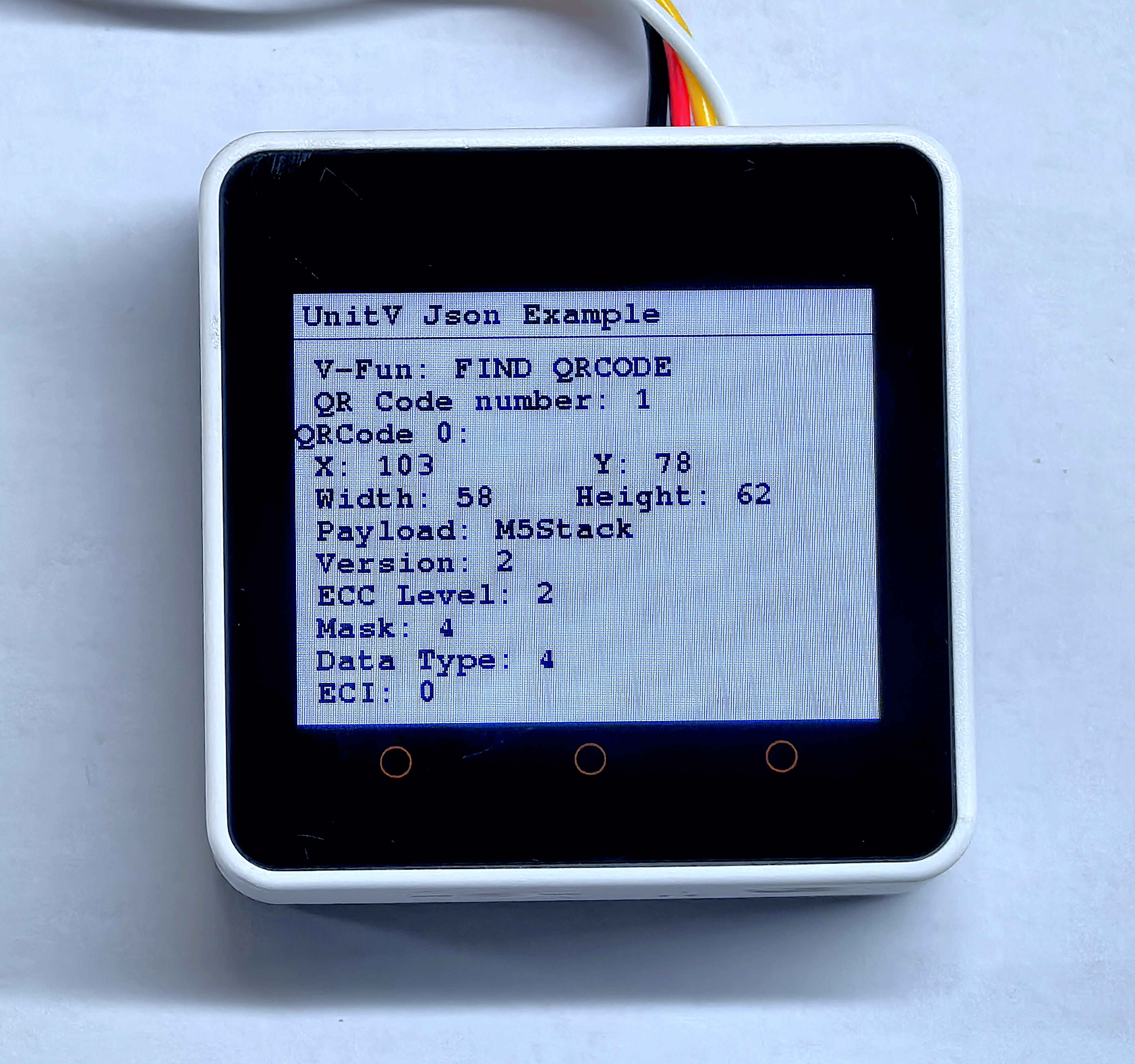
4.6 条形码识别
条形码识别功能 JSON 数据格式详见此处。
#include <M5Unified.h>
#include <M5GFX.h>
#include <Arduino_JSON.h>
M5GFX display;
void setup() {
display.begin();
display.setRotation(1);
display.clear(TFT_WHITE);
display.setFont(&fonts::FreeMonoBold9pt7b);
display.setTextColor(TFT_BLACK);
delay(100);
display.drawString("UnitV Json Example", 5, 5);
display.drawLine(0, 25, 320, 25, TFT_BLACK);
Serial.begin(115200);
Serial2.begin(115200, SERIAL_8N1, 13, 14);//PORT.C
JSONVar obj;
obj["FIND CODE"] = 1.0;
obj["mode"] = "BARCODE"; // Recognition mode, optional: QRCODE, APRILTAG, DATAMATRIX, BARCODE
String jsonString = JSON.stringify(obj);
Serial2.println(jsonString);
Serial2.flush();
}
void loop() {
if (Serial2.available() > 0) {
String line = Serial2.readStringUntil('\r');
while (line.length() && line[0] != '{') { // clear '\0'
line.remove(0, 1);
}
Serial2.flush();
JSONVar code_obj = JSON.parse(line);
// JSON.typeof(jsonVar) can be used to get the type of the var
if (!(JSON.typeof(code_obj) == "undefined")){
display.fillRect(0, 35, 320, 205, TFT_WHITE);
Serial.println(">>>>>>>>>>>>>>>>>>>>>>>>>>>>>>>>>>");
Serial.println("M5Stack Barcode Detect V-Func example");
if (code_obj.hasOwnProperty("FUNC")) {
Serial.print("V-Function = ");
Serial.println((const char*) code_obj["FUNC"]);
display.setCursor(0, 35);
display.printf(" V-Fun: %s\n", (const char*) code_obj["FUNC"]);
}
int barcode_cnt = 0;
if (code_obj.hasOwnProperty("count")) {
barcode_cnt = (int)code_obj["count"];
Serial.printf("Barcode number = %d\n", barcode_cnt);
display.printf(" Barcode number: %d\n", barcode_cnt);
}
for (int i = 0; i < barcode_cnt; i++) {
Serial.print("Barcode ");
Serial.print(i);
display.printf("Barcode %d:", i);
Serial.print(":\r\n\tX:");
Serial.println((int) code_obj[String(i)]["x"]);
display.printf("\r\n\t X: %d", (int) code_obj[String(i)]["x"]);
Serial.print("\tY:");
Serial.println((int) code_obj[String(i)]["y"]);
display.printf("\r\n\t Y: %d", (int) code_obj[String(i)]["y"]);
Serial.print("\tWidth:");
Serial.println((int) code_obj[String(i)]["w"]);
display.printf("\r\n\t Width: %d", (int) code_obj[String(i)]["w"]);
Serial.print("\tHeight:");
Serial.println((int) code_obj[String(i)]["h"]);
display.printf("\r\n\t Height: %d", (int) code_obj[String(i)]["h"]);
Serial.print("\tPayload:");
Serial.println((const char*) code_obj[String(i)]["payload"]);
display.printf("\r\n\t Payload: %s", (const char*) code_obj[String(i)]["payload"]);
Serial.print("\tType:");
Serial.println((int) code_obj[String(i)]["type"]);
display.printf("\r\n\t Type: %d", (int) code_obj[String(i)]["type"]);
Serial.print("\tRotation:");
Serial.println((double) code_obj[String(i)]["rotation"]);
display.printf("\r\n\t Rotation: %f", (double) code_obj[String(i)]["rotation"]);
Serial.print("\tQuality:");
Serial.println((int) code_obj[String(i)]["quality"]);
display.printf("\r\n\t Quality: %d", (int) code_obj[String(i)]["quality"]);
}
Serial.println("<<<<<<<<<<<<<<<<<<<<<<<<<<<<<<<<<<");
}
delay(50);
}
}扫描下方条形码,检测结果如下图所示。

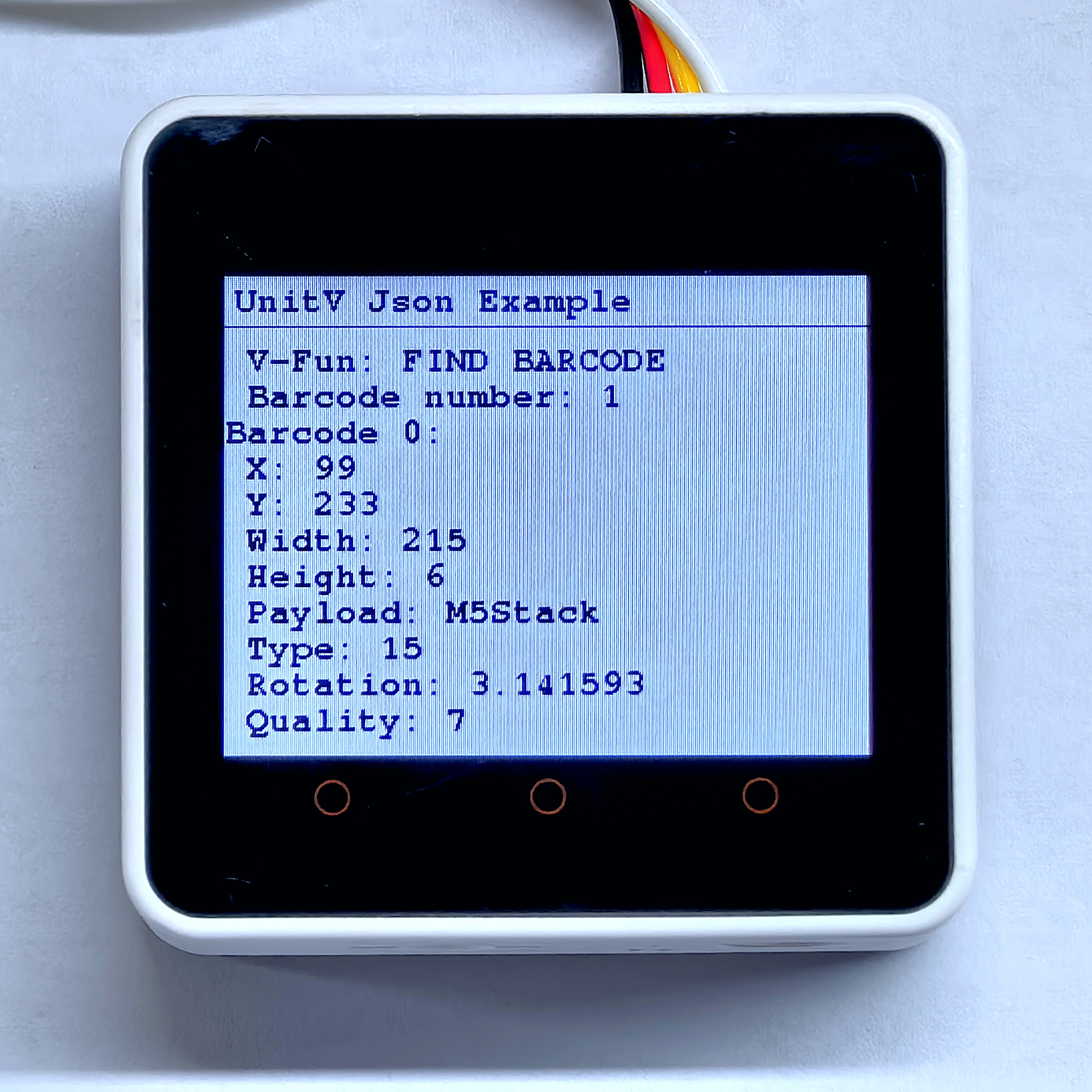
4.7 Datamatrix码识别
Datamatrix码识别功能 JSON 数据格式详见此处。
#include <M5Unified.h>
#include <M5GFX.h>
#include <Arduino_JSON.h>
M5GFX display;
void setup() {
display.begin();
display.setRotation(1);
display.clear(TFT_WHITE);
display.setFont(&fonts::FreeMonoBold9pt7b);
display.setTextColor(TFT_BLACK);
delay(100);
display.drawString("UnitV Json Example", 5, 5);
display.drawLine(0, 25, 320, 25, TFT_BLACK);
Serial.begin(115200);
Serial2.begin(115200, SERIAL_8N1, 13, 14);//PORT.C
JSONVar obj;
obj["FIND CODE"] = 1.0;
obj["mode"] = "DATAMATRIX"; // Recognition mode, optional: QRCODE, APRILTAG, DATAMATRIX, BARCODE
String jsonString = JSON.stringify(obj);
Serial2.println(jsonString);
Serial2.flush();
}
void loop() {
if (Serial2.available() > 0) {
String line = Serial2.readStringUntil('\r');
while (line.length() && line[0] != '{') { // clear '\0'
line.remove(0, 1);
}
Serial2.flush();
JSONVar code_obj = JSON.parse(line);
// JSON.typeof(jsonVar) can be used to get the type of the var
if (!(JSON.typeof(code_obj) == "undefined")){
display.fillRect(0, 40, 320, 200, TFT_WHITE);
Serial.println(">>>>>>>>>>>>>>>>>>>>>>>>>>>>>>>>>>");
Serial.println("M5Stack DataMatrix Detect V-Func example");
if (code_obj.hasOwnProperty("FUNC")) {
Serial.print("V-Function = ");
Serial.println((const char*) code_obj["FUNC"]);
display.setCursor(0, 35);
display.printf(" V-Fun: %s\n", (const char*) code_obj["FUNC"]);
}
int dm_cnt = 0;
if (code_obj.hasOwnProperty("count")) {
dm_cnt = (int)code_obj["count"];
Serial.printf("DataMatrix number = %d\n", dm_cnt);
display.printf(" DataMatrix number: %d\n", dm_cnt);
}
for (int i = 0; i < dm_cnt; i++) {
Serial.print("DataMatrix ");
Serial.print(i);
display.printf("DataMatrix %d:", i);
Serial.print(":\r\n\tX:");
Serial.println((int) code_obj[String(i)]["x"]);
display.printf("\r\n\t X: %d", (int) code_obj[String(i)]["x"]);
Serial.print("\tY:");
Serial.println((int) code_obj[String(i)]["y"]);
display.printf(" Y: %d", (int) code_obj[String(i)]["y"]);
Serial.print("\tWidth:");
Serial.println((int) code_obj[String(i)]["w"]);
display.printf("\r\n\t Width: %d", (int) code_obj[String(i)]["w"]);
Serial.print("\tHeight:");
Serial.println((int) code_obj[String(i)]["h"]);
display.printf(" Height: %d", (int) code_obj[String(i)]["h"]);
Serial.print("\tPayload:");
Serial.println((const char*) code_obj[String(i)]["payload"]);
display.printf("\r\n\t Payload: %s", (const char*) code_obj[String(i)]["payload"]);
Serial.print("\tRotation:");
Serial.println((double) code_obj[String(i)]["rotation"]);
display.printf("\r\n\t Rotation: %f", (double) code_obj[String(i)]["rotation"]);
Serial.print("\tRows:");
Serial.println((int) code_obj[String(i)]["rows"]);
display.printf("\r\n\t Rows: %d", (int) code_obj[String(i)]["rows"]);
Serial.print("\tColumns:");
Serial.println((int) code_obj[String(i)]["columns"]);
display.printf(" Columns: %d", (int) code_obj[String(i)]["columns"]);
Serial.print("\tCapacity:");
Serial.println((int) code_obj[String(i)]["capacity"]);
display.printf("\r\n\t Capacity: %d", (int) code_obj[String(i)]["capacity"]);
Serial.print("\tPadding:");
Serial.println((int) code_obj[String(i)]["padding"]);
display.printf("\r\n\t Padding: %d", (int) code_obj[String(i)]["padding"]);
}
Serial.println("<<<<<<<<<<<<<<<<<<<<<<<<<<<<<<<<<<");
}
delay(50);
}
}扫描下方左边 Datamatrix 码,检测结果如下方右图所示。

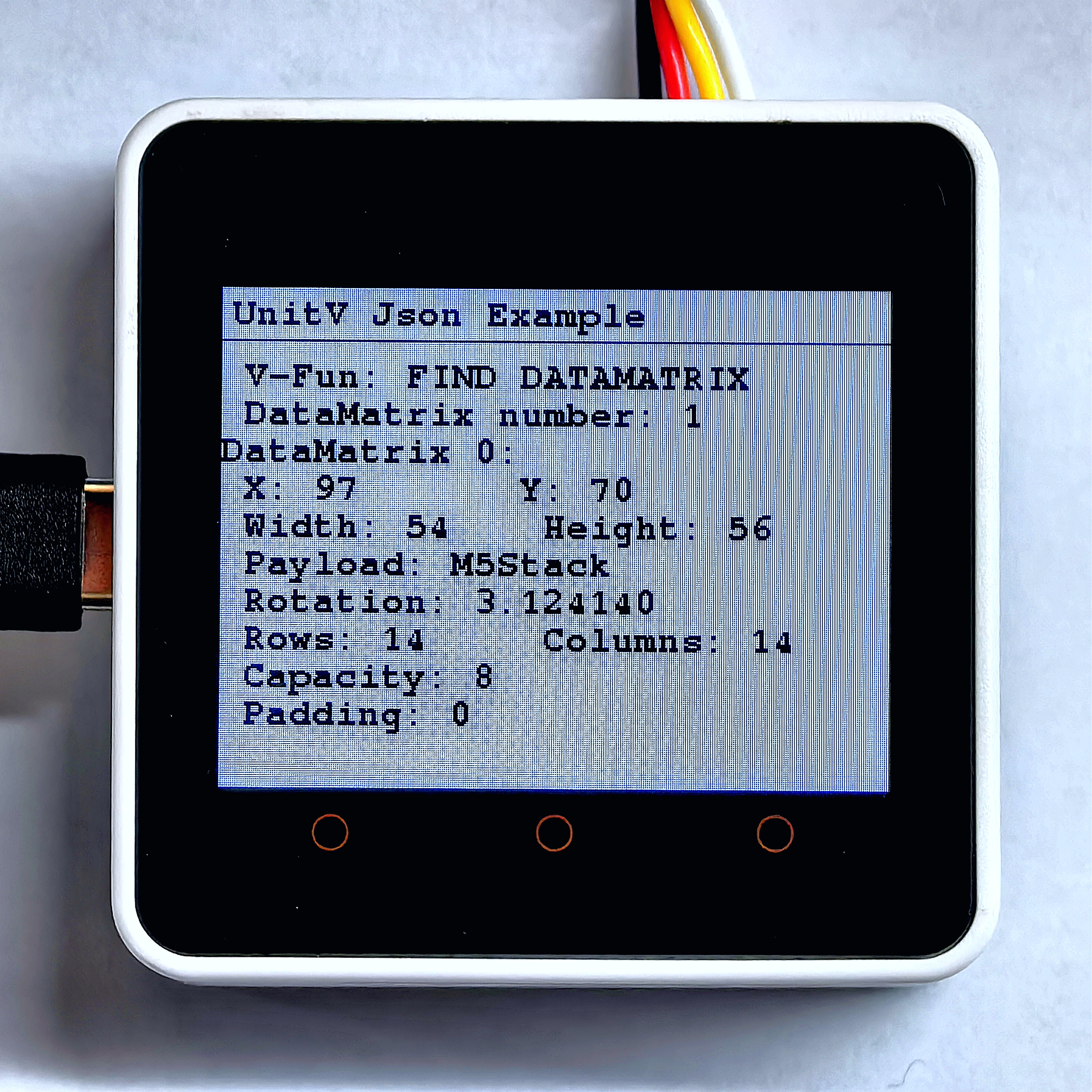
4.8 Apriltag码识别
Apriltag码识别功能 JSON 数据格式详见此处。
#include <M5Unified.h>
#include <M5GFX.h>
#include <Arduino_JSON.h>
M5GFX display;
void setup() {
display.begin();
display.setRotation(1);
display.clear(TFT_WHITE);
display.setFont(&fonts::Font2);
display.setTextColor(TFT_BLACK);
delay(100);
display.drawString("UnitV Json Example", 2, 2);
display.drawLine(0, 20, 320, 20, TFT_BLACK);
Serial.begin(115200);
Serial2.begin(115200, SERIAL_8N1, 13, 14);//PORT.C
JSONVar obj;
obj["FIND CODE"] = 1.0;
obj["mode"] = "APRILTAG"; // Recognition mode, optional: QRCODE, APRILTAG, DATAMATRIX, BARCODE
String jsonString = JSON.stringify(obj);
Serial2.println(jsonString);
Serial2.flush();
}
void loop() {
if (Serial2.available() > 0) {
String line = Serial2.readStringUntil('\r');
while (line.length() && line[0] != '{') { // clear '\0'
line.remove(0, 1);
}
Serial2.flush();
JSONVar code_obj = JSON.parse(line);
// JSON.typeof(jsonVar) can be used to get the type of the var
if (!(JSON.typeof(code_obj) == "undefined")){
display.fillRect(0, 25, 320, 215, TFT_WHITE);
Serial.println(">>>>>>>>>>>>>>>>>>>>>>>>>>>>>>>>>>");
Serial.println("M5Stack AprilTag Detect V-Func example");
if (code_obj.hasOwnProperty("FUNC")) {
Serial.print("V-Function = ");
Serial.println((const char*) code_obj["FUNC"]);
display.setCursor(0, 25);
display.printf(" V-Fun: %s\n", (const char*) code_obj["FUNC"]);
}
int april_cnt = 0;
if (code_obj.hasOwnProperty("count")) {
april_cnt = (int)code_obj["count"];
Serial.printf("AprilTag number = %d\n", april_cnt);
display.printf(" AprilTag number: %d\n", april_cnt);
}
for (int i = 0; i < april_cnt; i++) {
Serial.print("AprilTag ");
Serial.print(i);
display.printf("AprilTag %d:", i);
Serial.print(":\r\n\tX:");
Serial.println((int) code_obj[String(i)]["x"]);
display.printf(" X: %d", (int) code_obj[String(i)]["x"]);
Serial.print("\tY:");
Serial.println((int) code_obj[String(i)]["y"]);
display.printf(" Y: %d", (int) code_obj[String(i)]["y"]);
Serial.print("\tWidth:");
Serial.println((int) code_obj[String(i)]["w"]);
display.printf(" Width: %d", (int) code_obj[String(i)]["w"]);
Serial.print("\tHeight:");
Serial.println((int) code_obj[String(i)]["h"]);
display.printf(" Height: %d", (int) code_obj[String(i)]["h"]);
Serial.print("\tID:");
Serial.println((int) code_obj[String(i)]["id"]);
display.printf("\r\n\t ID: %d", (int) code_obj[String(i)]["id"]);
Serial.print("\tFamily:");
Serial.println((int) code_obj[String(i)]["family"]);
display.printf(" Family: %d", (int) code_obj[String(i)]["family"]);
Serial.print("\tCX:");
Serial.println((int) code_obj[String(i)]["cx"]);
display.printf(" CX: %d", (int) code_obj[String(i)]["cx"]);
Serial.print("\tCY:");
Serial.println((int) code_obj[String(i)]["cy"]);
display.printf(" CY: %d", (int) code_obj[String(i)]["cy"]);
Serial.print("\tRotation:");
Serial.println((double) code_obj[String(i)]["rotation"]);
display.printf("\r\n\t Rotation: %f", (double) code_obj[String(i)]["rotation"]);
Serial.print("\tDecision margin:");
Serial.println((double) code_obj[String(i)]["decision_margin"]);
display.printf("\r\n\t Decision margin: %f", (double) code_obj[String(i)]["decision_margin"]);
Serial.print("\tHamming:");
Serial.println((int) code_obj[String(i)]["hamming"]);
display.printf(" Hamming: %d", (int) code_obj[String(i)]["hamming"]);
Serial.print("\tGoodness:");
Serial.println((double) code_obj[String(i)]["goodness"]);
display.printf("\r\n\t Goodness: %f", (double) code_obj[String(i)]["goodness"]);
Serial.print("\tX translation:");
Serial.println((double) code_obj[String(i)]["x_translation"]);
display.printf("\r\n\t X translation: %f", (double) code_obj[String(i)]["x_translation"]);
Serial.print("\tY translation:");
Serial.println((double) code_obj[String(i)]["y_translation"]);
display.printf("\r\n\t Y translation: %f", (double) code_obj[String(i)]["y_translation"]);
Serial.print("\tZ translation:");
Serial.println((double) code_obj[String(i)]["z_translation"]);
display.printf("\r\n\t Z translation: %f", (double) code_obj[String(i)]["z_translation"]);
Serial.print("\tX rotation:");
Serial.println((double) code_obj[String(i)]["x_rotation"]);
display.printf("\r\n\t X rotation: %f", (double) code_obj[String(i)]["x_rotation"]);
Serial.print("\tY rotation:");
Serial.println((double) code_obj[String(i)]["y_rotation"]);
display.printf("\r\n\t Y rotation: %f", (double) code_obj[String(i)]["y_rotation"]);
Serial.print("\tZ rotation:");
Serial.println((double) code_obj[String(i)]["z_rotation"]);
display.printf("\r\n\t Z rotation: %f", (double) code_obj[String(i)]["z_rotation"]);
}
Serial.println("<<<<<<<<<<<<<<<<<<<<<<<<<<<<<<<<<<");
}
delay(50);
}
}扫描下方左边 Apriltag 码,检测结果如下方右图所示。

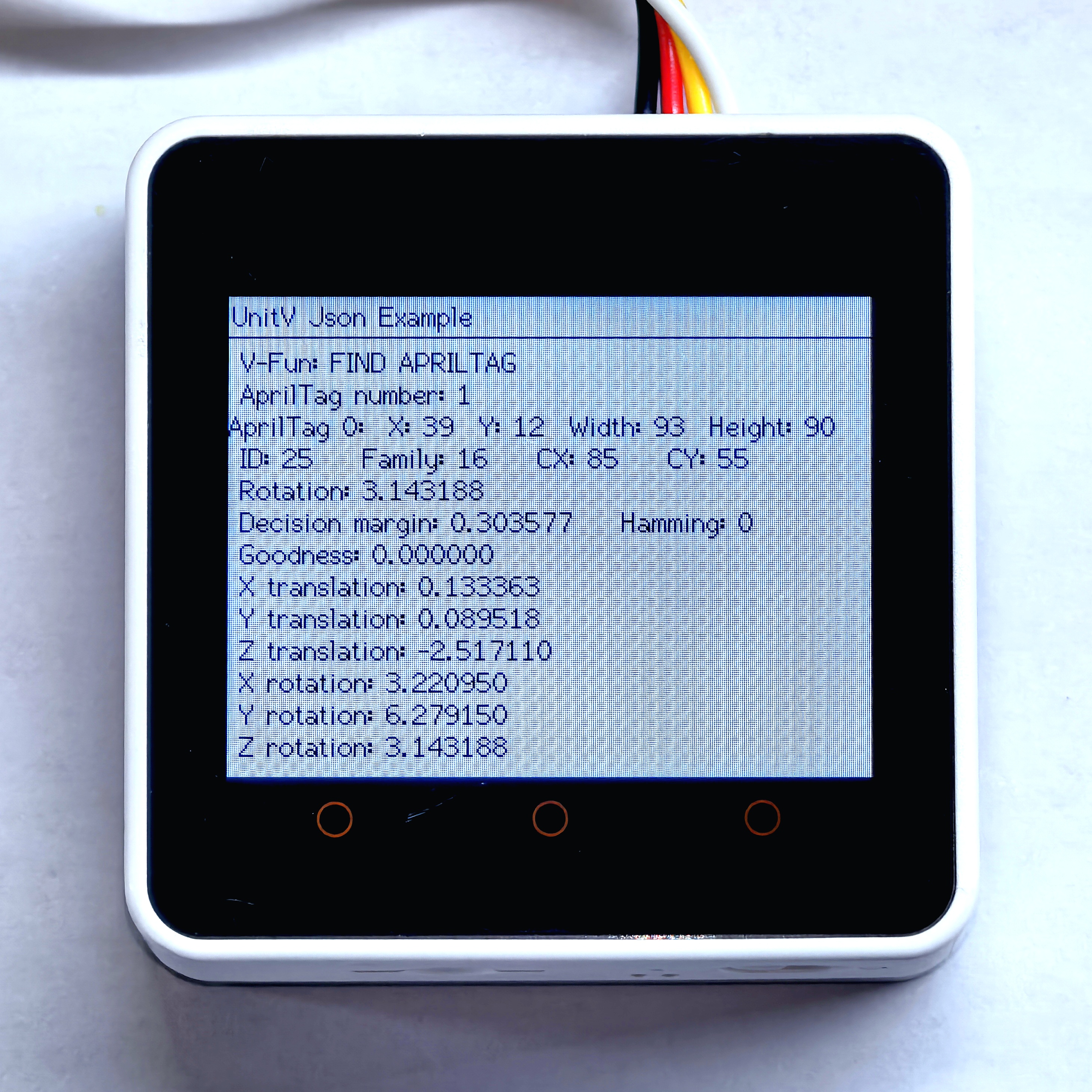
4.9 巡线
该功能固件如下:
巡线功能需要在 UnitV/StickV 上电后设置追踪线条颜色参数才能正常使用,颜色参数获取需要使用LAB 取色工具。
获取及配置颜色参数与颜色追踪相同,权重(weight)取样区域示例图如下,请根据自身需要自行设置比例值。
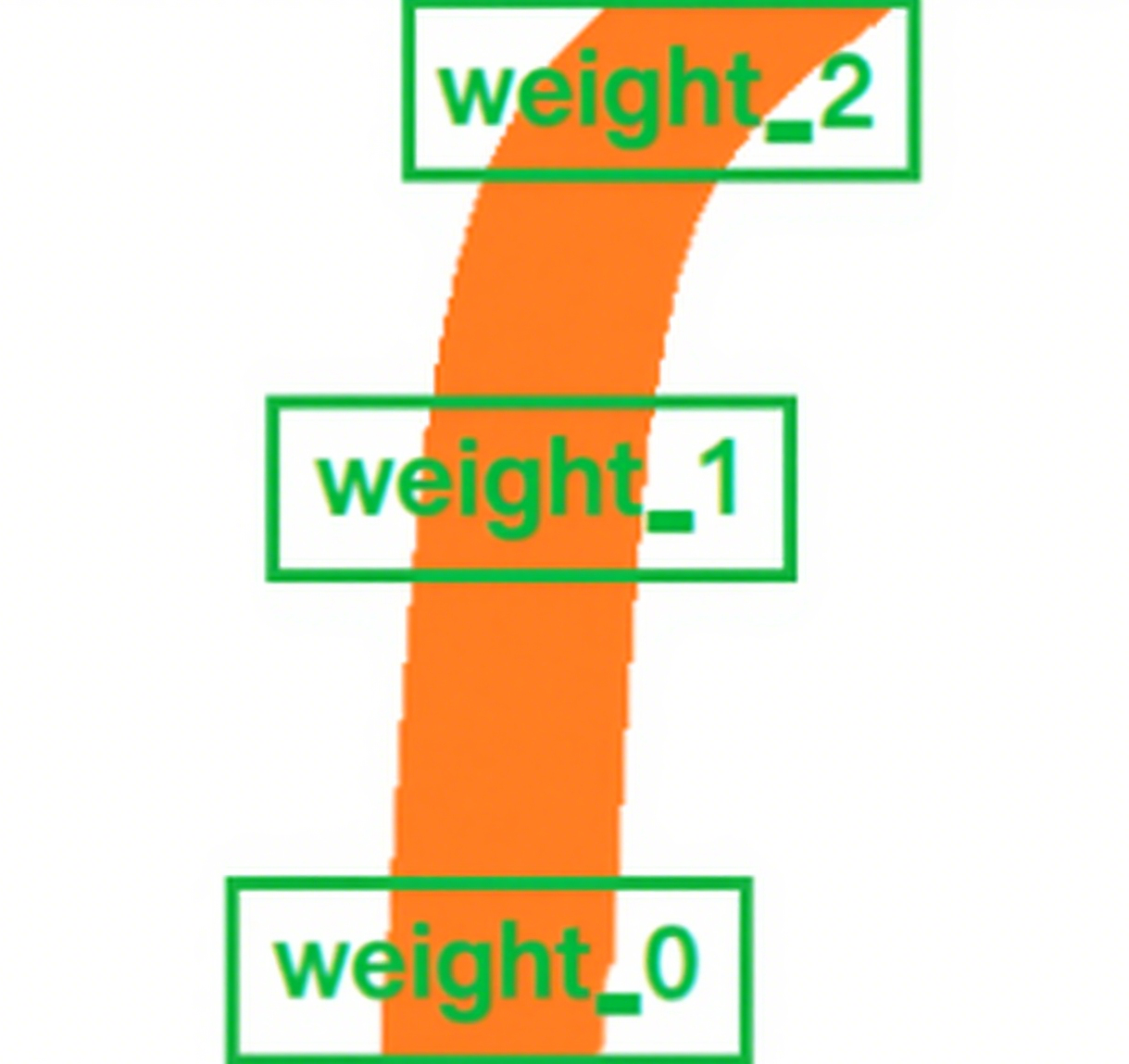
巡线功能 JSON 数据格式详见此处。
#include <M5Unified.h>
#include <M5GFX.h>
#include <Arduino_JSON.h>
M5GFX display;
void setup() {
display.begin();
display.setRotation(1);
display.clear(TFT_WHITE);
display.setFont(&fonts::FreeMonoBold9pt7b);
display.setTextColor(TFT_BLACK);
delay(100);
display.drawString("UnitV Json Example", 5, 5);
display.drawLine(0, 25, 320, 25, TFT_BLACK);
Serial.begin(115200);
Serial2.begin(115200, SERIAL_8N1, 13, 14);//PORT.C
//Setting JSON
JSONVar obj;
obj["LINE TRACKER"] = 1.0;
obj["thr_w"] = 20;
obj["thr_h"] = 20;
obj["stepx"] = 2;
obj["stepy"] = 2;
obj["merge"] = 10;
//Please fill in the below six parameters with the values extracted from the LAB color selection tool.
obj["Lmin"] = 0;
obj["Lmax"] = 100;
obj["Amin"] = 51;
obj["Amax"] = 61;
obj["Bmin"] = 34;
obj["Bmax"] = 44;
obj["weight_0"] = 0.1;
obj["weight_1"] = 0.3;
obj["weight_2"] = 0.6;
String jsonString = JSON.stringify(obj);
Serial2.println(jsonString);
Serial2.flush();
}
void loop() {
if (Serial2.available() > 0) {
String line = Serial2.readStringUntil('\r');
while (line.length() && line[0] != '{') { // clear '\0'
line.remove(0, 1);
}
Serial2.flush();
JSONVar line_obj = JSON.parse(line);
// JSON.typeof(jsonVar) can be used to get the type of the var
if (!(JSON.typeof(line_obj) == "undefined")){
display.fillRect(0, 40, 320, 200, TFT_WHITE);
Serial.println(">>>>>>>>>>>>>>>>>>>>>>>>>>>>>>>>>>");
Serial.println("M5Stack Line Tracker V-Func example");
if (line_obj.hasOwnProperty("FUNC")) {
Serial.print("V-Function = ");
Serial.println((const char*) line_obj["FUNC"]);
display.setCursor(0, 35);
display.printf(" V-Fun: %s\n", (const char*) line_obj["FUNC"]);
}
if (line_obj.hasOwnProperty("angle")) {
Serial.print("Angle: ");
Serial.println((double) line_obj["angle"]);
display.printf(" Angle: %f\n", (double) line_obj["angle"]);
}
Serial.println("<<<<<<<<<<<<<<<<<<<<<<<<<<<<<<<<<<");
} else {
return;
}
}
} 例程成功运行时,主机会实时显示打印转弯角度。
